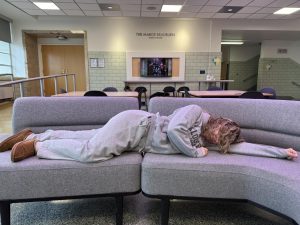Can we really keep denying Climate Change?
As the world’s climate shows signs of drastic fluctuation, it is long past time to take action.
December 3, 2018
The devastation produced by Hurricane Michael, the United Nations report on climate change, and the very real actions taken to reduce carbon footprints are all warning of a single problem: that the impact of climate change is already here and that things will continue to get even worse without drastic measures being taken. The failure of Initiative 1631 in Washington along with others throughout America during midterms indicate a disturbing unwillingness to take action.
The report was created by the Intergovernmental Panel on Climate Change (IPCC) for the U.N Framework Convention on Climate Change which invited the IPCC to assist in 2015 after the Paris Agreements were signed, according to the summary for policymakers released by the IPCC.
On October 8th, the Intergovernmental Panel on Climate Change (IPCC) released a report outlining the impacts of a 1.5°C [2.7°F] temperature increase on the world and what actions can be taken to limit global warming to that target. This target temperature was chosen because it could prevent certain problems caused by even higher temperatures.
For example, limiting warming could prevent destabilizing polar ice sheets and causing sea levels to rise even higher than the report’s target, reports The Atlantic.
“It may be possible to preserve those large stores of ice at 2.7 degrees, scientists have found.”
Also among the dangers of a 2°C or higher rise is a loss of ecosystems, damages to crop yields globally, and higher sea level rise according to the report.
The U.N further outlined the damages caused by warming, as well as establishing what must be done to limit it. The report said that a 1.5°C increase would be a best-case scenario for humanity and that without concerted effort temperatures will rise even higher.
‘“Rapid and far-reaching’ transitions in land, energy, industry, buildings, transport, and cities” would be required to limit global warming to 1.5°C,” the summary stated.
Global temperatures have already risen 1°C [1.8°F] above the recorded average during the 21st century, reported the New York Times.
The IPCC report is useful to both policymakers and citizens alike, providing areas to work on to limit global warming as well as potential adaptations to mitigate the impact of changes to ecosystems. CO2 emissions are the main factor at work, and reducing emissions is the primary method for keeping temperatures under control. Keeping global warming within planned limits will not be easy.
“The rates of system changes associated with limiting global warming to 1.5°C with no or limited overshoot have occurred in the past within specific sectors, technologies, and spatial contexts, but there is no documented historic precedent for their scale”
And the effects of climate change are already reaping havoc. Hurricanes and climate change have not always gone hand and hand, and proving they are connected is not the easiest thing. With the recent category 4 Hurricane Michael that hit landfall in the Florida Panhandle, just northwest of Mexico Beach on the 10th of October, it is apparent that climate change was no coincidence in this powerful and deadly storm.
“There is no doubt that we will be playing catch-up with our new climate reality for decades to come, even as it shifts under our feet, in a vicious and unforgiving game of cat and mouse” said the Washington Post.
The typical Atlantic Hurricane season typically runs from around the first of June to the end of November. No hurricane has been this powerful to hit this time of year, let alone to hit the Florida panhandle since the year 1851, according to the Fortune. Because of the 155 mph winds and intense flooding, the storm has taken 36 lives as of the 20th of October, 20 days after Michael made landfall. The “rapid intensification” of Michael’s winds, according to CBS News exceeded 80 mph in 48 hours, exceeding the typical rapid intensification of a normal hurricane which tends to be 35mph in 24 hours. With these statistics, this increase of rapid intensification will continue to rise in years to come with future hurricanes. The death toll may continue to rise as Florida and other Southern states such as Georgia, North Carolina, and Virginia are trying to rebuild themselves according to CNN. Hurricane Michael defied all odds and opened the East Coast’s eyes to this new reality it will be facing from now on and how the United States can go on from here.
Michael was not the first Hurricane to draw attention to this new problem of climate change affecting our world. Katrina, Sandy, Harvey, Maria, and Florence are all other hurricanes that as stated by the Washington Post were “all supercharged by manmade climate change to some degree: We are exceptionally ill-prepared for the climate threats that are unfolding today, let alone those of the next decade.”
After each hurricane we experience shows incredible destruction to areas, most of the time high death tolls in those areas affected. Sadly, within the recent history of the hurricanes the United States have experienced, they have hit areas of high poverty, which usually includes minorities and people of ethnicity. According to Brookings, people living in those areas tend to be more prone to natural disasters, such as Hurricanes. The biggest issue is that when a hurricane hits, they struggle the most to recover and regain their footing again. These people are the ones that need help the most and are desperate to find a way to stop these destructive hurricanes from hitting them again. By getting climate change under control, citizens can try to prevent these people from going through natural disasters like these Hurricanes one action at a time. Building a community where people take action to help stop this problem from progressing any farther, is an admirable task, and Bishop Blanchet can be a place to do that.
Climate change isn’t going away, and is affecting more than previously thought. As consumers, each of us are part of this global problem. According to the National Oceanic and Atmospheric Administration’s Geophysical Fluid Dynamics Laboratory in Princeton, New Jersey, the rising of the sea surface temperatures due to the increase of “greenhouse gas” emissions are adding to the fact that more larger number hurricanes like Michael are headed towards America in the future, and there is no stopping them. No one can deny this new world problem of climate change any longer, but there are ways to help and make a slight difference in this new staggering statistic that will be greatly affecting the future.
So what can be done? First off, Bishop Blanchet is already an environmentally conscious workplace. The school counts among its approved service agencies nine different environment and rebuilding-related organizations with which students can work for their mandatory service hours; it also encourages students to consider their impact on the planet during Earth Week every April; However, the community has many available options to reach the outlined goal.
To put the burden of emissions on Bishop Blanchet is to have an incomplete view of climate change as a whole. Blanchet as a school is an insignificantly small part of the global equation. But as a community Bishop Blanchet has the ability to enact change.
Bishop Blanchet has taken on the responsibilities it has because as a community in the Pacific Northwest, it already faces the impact of climate change.
“Flooding and erosion from sea-level rise are likely to damage homes, highways, public transportation systems, and threaten marine life and coastal ecosystems,” said The Climate Reality Project, a group founded with the stated goal of mobilizing people and groups to combat climate change worldwide. The community has embarked on these actions not only as responsible stewards of the world but as people who saw a problem impacting them and worked towards making an impact to change it.
For students and faculty who do wish to take action beyond what Blanchet has already done, there are multiple paths of action available. Someone’s carbon footprint is defined by Carbon Trust as the amount of greenhouse-effect related emissions that are caused directly or indirectly by someone or something. Reducing this carbon footprint, both one’s personal footprint and that of other people, groups, or organizations, is the most direct way to limit global warming.
In Washington, Initiative 1631, which would have attached fees to excess carbon emissions, failed to pass in the 2018 midterms. This initiative would have discouraged Washington businesses from relying on fossil fuels and pushed the state towards more sustainable energy.
According the the Seattle Times, opposition to the initiative was largely bankrolled by the oil industry. Putting Bishop Blanchet’s support behind similar initiatives in the future will go a long way towards enacting change. Since nobody in the Blanchet community can reasonably deny the impacts of global warming, taking action in this way is just an extension of supporting the community’s own best interests.





